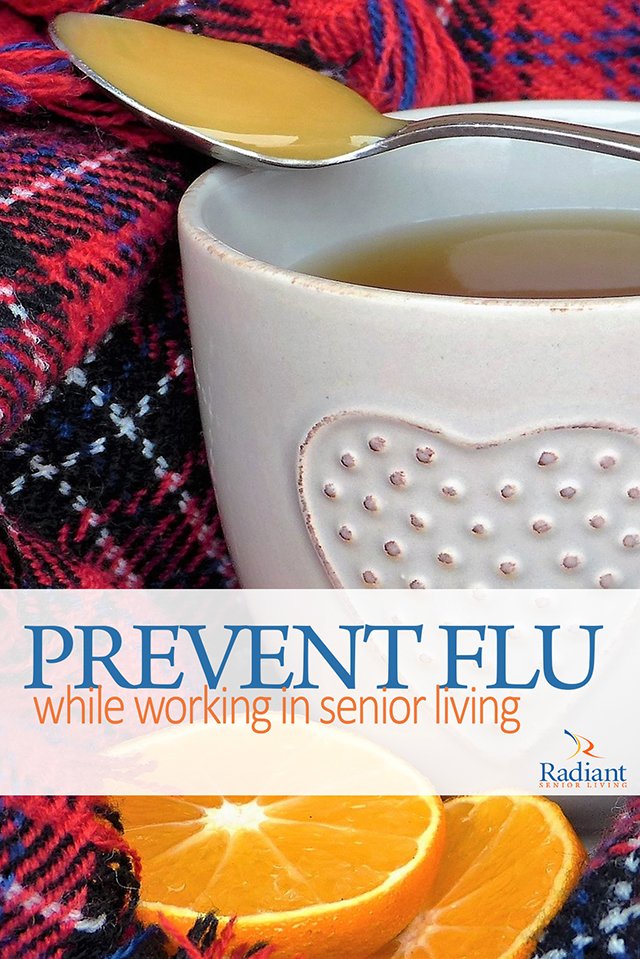Flu Prevention Tips for Senior Living Staff
Come autumn, and through winter each year, senior living staff aim to prevent flu at work. Flu can spread easily if it comes into a senior living community (or any style of a residential living community) and residents over 65 are at high risk for flu-related complications.Preventing flu in senior living communities is best achieved as a group effort. Staff should get flu shots, learn about the flu, stop germs from spreading, and live healthy lifestyles.
Prevent Flu at Work in Senior Living
Before flu season, senior living staff should commit to preventing flu together. Prepare by having a plan if flu comes; know if and when flu shots are available to employees; and ensure several people know how to do a job if a staff member gets the flu and needs their shift covered.
Get A Flu Shot
The best way to prevent flu in senior living is for staff and residents to get an annual flu shot. Those who wish to get a flu shot should consult their medical professionals and disclose their allergies to them. Those with a history of Guillain-Barré Syndrome should not get the flu shot.Typically, flu is strongest in December, January, and February in the United States, but it can come earlier. Staff should ideally get the flu shot in late September or early October, but it is never too late to get vaccinated. It takes two weeks for a flu shot to become fully effective.Preventing the flu goes beyond just getting the shot. Stop illness from coming and spreading by learning about it and knowing how to combat it.
Five Flu Facts
A great line of defense against flu is being educated about it. Know what flu is and how it spreads to help prevent it.
- What is the flu? The flu is a contagious respiratory illness brought on by influenza viruses that infect the nose, throat, and lungs. Types A and B, and their sub-types are responsible for annual epidemics.
- How does flu spread? Flu is believed to spread through tiny droplets when people with a flu cough, sneeze, or talk. The droplets can transfer to mouths or noses of those within six feet. They can also reach a surface and live there for two hours or more that a person may touch and transfer to their mouth, nose, or eyes.
- If a person catches flu, how long is it between exposure and infection? The time between flu exposure and infection is often two days, but can be one to four.
- How long is a person with flu contagious? Those with flu are most contagious in the first three to four days after their illness starts, and they can pass it on before or while knowing they are sick.
- Who is most at risk for flu-related complications? Those who are 65 or older, young children, pregnant women, and those with chronic conditions like asthma or heart disease are higher at risk for complications related to flu.
Five Ways to Prevent Germ Spreading
To preventing senior living communities from flu, employees need to practice good personal-hygiene and self-care at work and home. There are many recommended germ-spreading prevention practices.
- Avoid close contact with others if sick. If an employee is sick and can stay home, they should do so, especially if they have a fever or a cough. If caring for a senior who is ill, staff should wear gloves or a face mask to avoid germ transfer. Staff should still be attentive and caring while helping those with the flu.
- Cover mouth and nose with a tissue when coughing or sneezing. Staff members and residents should have access to tissues, and use them as needed. Used tissues should go straight into a waste basket. If a tissue is not available, sneezing into the upper sleeve or elbow is better than hands.
- Wash hands with soap and warm water for 15 or 20 seconds, several times daily. Definitely wash hands after coughing or sneezing. Sanitize hands to clean them several times daily if water is not available.
- Avoid contact with eyes, nose, and mouth. Though it may require self-reminding, this can prevent flu from spreading.
- Clean with disinfectant. Use a disinfectant to clean places people touch, like doorknobs, telephones, sink faucets, light and lamp switches, coffee tables, art materials, books, etc. Avoid breathing in chemicals and clean away from others, as breathing in disinfectants can be harmful.
Five Healthy Lifestyle Tips
Living a healthy lifestyle can help with immunity, illness recovery, overall health, and flu prevention.
- Exercise often. Try to get 30 minutes of physical activity at least 5 days a week.
- Get enough sleep. If under 65, get seven to nine hours of sleep at night.
- Eat nutritious foods and drink enough fluids. Follow a healthy dietary plan, like the Mediterranean Diet! Have a daily fluid intake of about 15.5 cups (for men) or 11.5 cups (for women).
- Manage stress. Take care of stress with exercise, writing, deep breathing, and trying to have a positive outlook.
- Keep medical appointments. Make sure to go to the doctor, dentist, and/or medical specialist, as needed.
Flu prevention in senior living is a multi-part process and it definitely takes a village, but a prepared team can be successful! Try out these tips for keeping staff and residents as healthy as possible through the fall and winter seasons.


